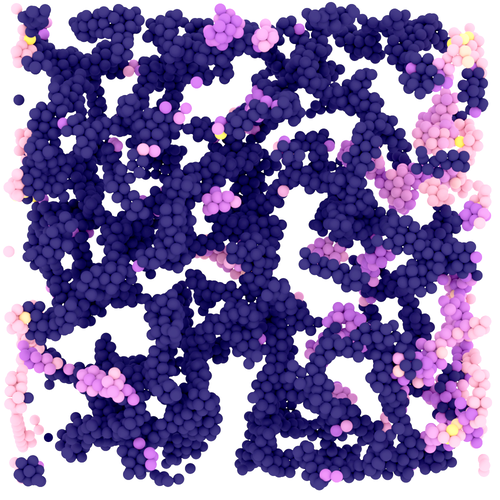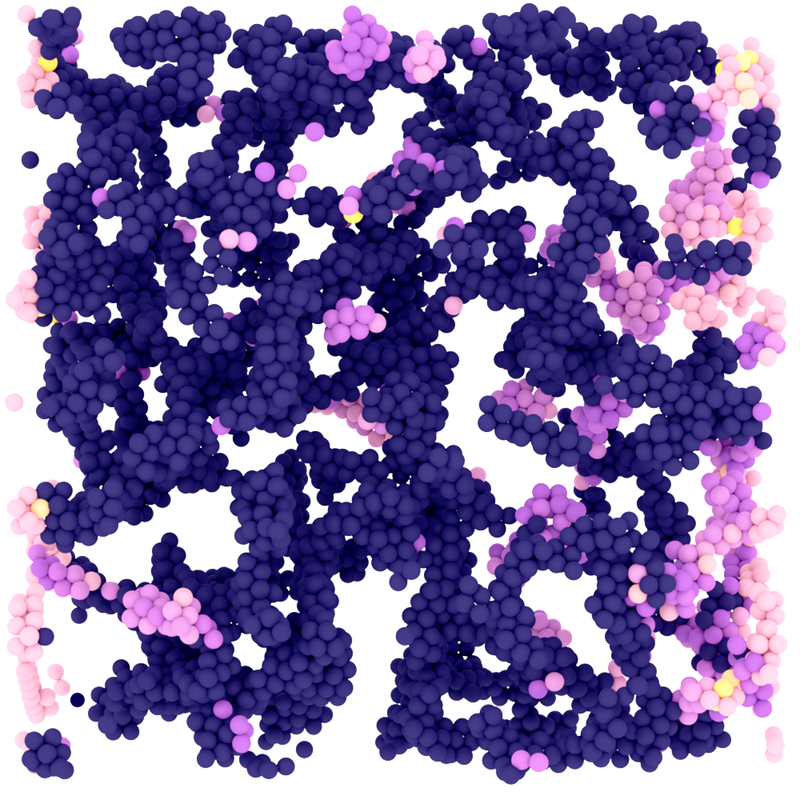Why Soft Solids Get Softer
Many foods like yogurt and mayonnaise can lose their stiffness over time, becoming more liquid-like. The cause of this fatigue in soft solids is not entirely clear, but new experimental work bolstered with simulations reveals one overlooked mechanism: permanent stretching of the microscopic strands that make up the material. The study, which investigates a plastic gel, shows that repeated strain causes the strands that make up the gel to lengthen, and this extra “slack” makes the gel weaker. The information could help in preventing food products from breaking down, as well as in developing soft mechanical parts that are more robust against fatigue.
For hard solids, like metals, fatigue has been well-studied. Repeated strain causes microcracks to form in the brittle internal structures. At some point, one of these cracks reaches a critical length, and the solid fractures. For soft disordered solids—such as food, cosmetics, and biological tissues—fatigue is less dramatic and less well understood. These materials typically consist of a messy network of microscopic strands or fibers. Researchers have generally assumed that repeated flexing causes strands to snap, which reduces the network connectivity and correspondingly makes the material less stiff.
However, recent work on gels by Joris Sprakel and colleagues at Wageningen University in the Netherlands suggested that strands in a gel change shape even when the gel is static [1]. This rearrangement, or strand plasticity, could play a more central role in gel fatigue than strand breakage. To investigate this possibility, the team has now looked at a gel undergoing mechanical strain. The gel in this case was created by coating 90-nanometer-diameter polystyrene beads with heat-activated glue. When warmed to 45∘C in a salt solution, the beads stuck together in a disordered network of long strands, each of which was several beads thick, like a vine of tightly packed grapes. This kind of network is representative of other soft solids.
The researchers placed this gel in an annulus-shaped chamber within a device called a rheometer, whose inner cylinder rotates to exert a shear strain on the sample. The team performed a series of strain cycles in which they applied strain (rotated the inner cylinder) up to a certain point and then released the strain by turning the cylinder back to its starting point. During each cycle, they recorded the stress in the gel by measuring the torque on the rheometer’s inner cylinder. The stress increased with the strain up to a maximum value, and in each strain cycle, this maximum was less than the previous cycle, a hint that the strands were permanently deformed by the strain.
The team performed additional strain cycles with higher amplitude and observed similar behavior. They also observed that the stiffness of the gel (determined from the slope of the stress vs strain plot) decreased as more cycles were performed. This softening can be explained as the strands getting longer and having more slack—like a spring that’s been stretched too much, says team member and graduate student Jan Maarten van Doorn.
Although these results were indicative of strand plasticity, strand breakage could still be the root cause of the gel weakening. To confirm the role of plasticity, the team performed detailed numerical simulations of a single strand exposed to a series of strain cycles. In response to the strain, the gel’s beads moved along the strand, causing it to stretch out and form thin “necks.” As in the experiments, the largest rearrangement occurred during the first cycle, causing the strand to be weaker (less elastic) for subsequent cycles. Other similarities between the simulations and the experiments supported the team’s claim that fatigue is a result of strand stretching and the buildup of slack, rather than strand breakage.
“Fatigue is currently the biggest poorly understood issue in materials physics, with lots of implications for materials design in various areas,” says condensed matter theorist Alessio Zaccone from the University of Cambridge, UK. The study by the Wageningen group is significant, he says, because it shows for the first time that fatigue in a prototypical soft material is controlled by the mechanical behavior of individual strands. He foresees this concept being incorporated into a predictive model of fatigue that could help prevent food degradation or aid in the design of soft mechanical joints. These plastic joints, consisting of networks of fibers, are increasingly used in aircraft manufacturing, says Zaccone.
This research is published in Physical Review Letters.
–Michael Schirber
Michael Schirber is a Corresponding Editor for Physics Magazine based in Lyon, France.
References
- J. M. van Doorn, J. Bronkhorst, R. Higler, T. van de Laar, and J. Sprakel, “Linking Particle Dynamics to Local Connectivity in Colloidal Gels,” Phys. Rev. Lett. 118, 188001 (2017).





